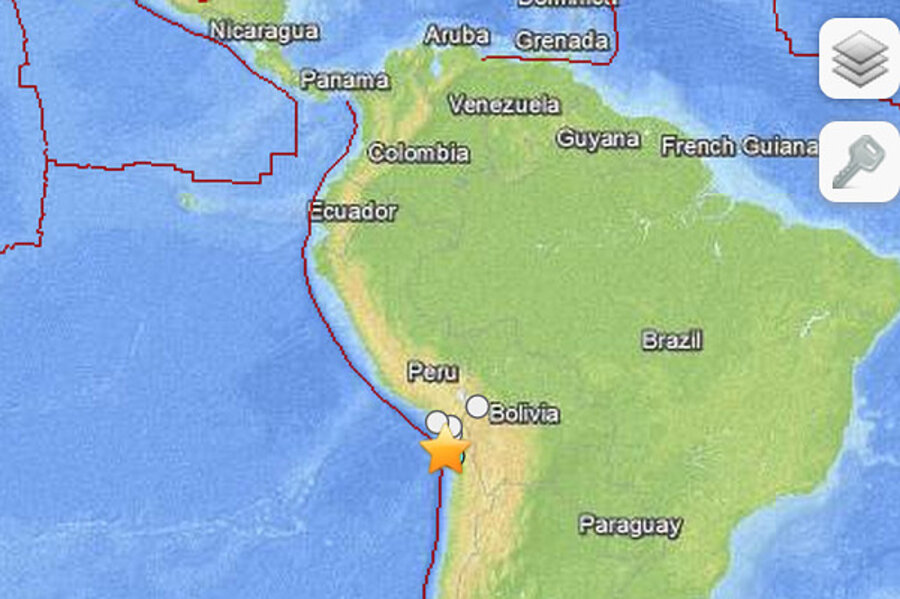Chile earthquake: Massive earthquake causes landslides, tsunami, 10 aftershocks
Loading...
| SANTIAGO, Chile
A powerful magnitude-8.2 earthquake struck off Chile's northern coast Tuesday night, causing landslides that blocked roads and setting off a small tsunami that forced an evacuation of coastal areas, but the region apparently escaped major damage and casualties.
In the city of Arica, 86 miles from the quake's epicenter, minor injuries were reported and some homes made of adobe were destroyed, officials said. The quake shook modern buildings in nearby Peru and in Bolivia's high altitude capital of La Paz.
The US Geological Survey initially reported the quake at 8.0, but later upgraded the magnitude. It said the quake struck 61 miles northwest of the Chilean city of Iquique at 8:46 p.m., hitting a region that has been rocked by numerous quakes over the past two weeks.
Psychiatrist Ricardo Yevenes said he was with a patient in Arica when the quake hit. "It quickly began to move the entire office, things were falling," he told local television. "Almost the whole city is in darkness."
The quake was so strong that the shaking experienced in Bolivia's capital about 290 miles away was the equivalent of a 4.5-magnitude tremor, authorities there said.
At least 10 strong aftershocks followed in the first few hours, including a 6.2 tremor. More aftershocks and even a larger quake could not be ruled out, said seismologist Mario Pardo at the University of Chile.
Some roads in northern Chile were blocked by landslides, causing traffic jams among people leaving the coast. But coastal residents remained calm as they head inland while waves measuring almost 2 meters (6 ½ feet) struck their cities.
Evacuations also were ordered in Peru, where waves 2 meters above normal forced about 200 people to leavethe seaside town of Boca del Rio. But there were no injuries or major damage, said Col. Enrique Blanco, the regional police chief in Tacna, a Peruvian city of 300,000 near the Chilean border. "The lights went out briefly, but were re-established," Blanco said.
A tsunami alert was issued by the Pacific Tsunami Warning Center for all of Latin America's Pacific coast.Chile's Emergency Office warned that a large tsunami wave was expected to hit Robinson Crusoe island and others in the Juan Fernandez archipelago, hundreds of miles off Chile's central coast. Residents there evacuated ahead of the first waves. Chile's Easter Island, much farther off in the Pacific, was expected to get hit after midnight Wednesday.
Authorities in the US state of Hawaii were on alert, but no tsunami watch was issued. The tsunami center said any higher waves would hit Hawaii starting 3:24 a.m. Hawaii Standard Time.
Chile is one of the world's most earthquake-prone countries because just off the coast, the Nazca tectonic plate plunges beneath the South American plate, pushing the towering Andes cordillera to ever-higher altitudes.
The latest activity began with a strong magnitude-6.7 quake on March 16 that caused more than 100,000 people to briefly evacuate low-lying areas. Hundreds of smaller quakes have followed in the weeks since, keeping people on edge as scientists said there was no way to tell if the unusual string of tremors was a harbinger of an impending disaster.
The last recorded big quake to hit far northern Chile around Iquique was a devastating magnitude-8.3 in 1877. It unleashed an 80-foot-high tsunami, causing major damage along the Chile-Peru coast and fatalities as far away as Hawaii and Japan.
A magnitude-8.8 quake and ensuing tsunami in central Chile in 2010 killed more than 500 people, destroyed 220,000 homes, and washed away docks, riverfronts and seaside resorts. That quake released so much energy, it actually it shortened the Earth's day by a fraction of a second by changing the planet's rotation.
The strongest earthquake ever recorded on Earth also happened in Chile — a magnitude-9.5 tremor in 1960 that killed more than 5,000 people.
Chile is the world's leading copper producing nation, and most of its mining industry is in the northern regions. Top mining companies said there was no serious damage to their operations so far.
Associated Press writers Eva Vergara in Santiago and Frank Bajak in Lima, Peru, contributed to this report.
Copyright 2014 The Associated Press. All rights reserved. This material may not be published, broadcast, rewritten or redistributed.





